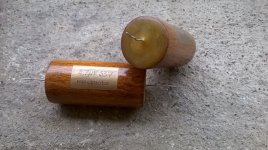Given the quality of the K73-16 I wouldn't bother with a Mundorf bypass. In my experience bypassing always buggers up the sound anyway: certain elements of the frequency spectrum are highlighted (perceived by many as an improvement) at the cost of overall coherence.
If you have the 401a, just leave the end caps off while you experiment. And watch the fibreglass stuffing; the fibres get everywhere
If you have the 401a, just leave the end caps off while you experiment. And watch the fibreglass stuffing; the fibres get everywhere

And bypass the fuses while you're at it.
The fuses and the pots will be bypassed. Fitting new resistors with values mid way. Other than poor contact I didn't find the pots had a big swing. Once all done and run in ill adjust values if I feel the need. After a re foam and new caps any factory setting on these will be obsolete.
Ill have to run the speakers in and be settled with any cap choices before re clothing.
They are quite good even without bypass.If you like open,detailed (bit bright) sound go for it.
I have ordered some now, need to hear but as so little cost its worth testing.
I wouldnt say I like bright but I do like ambience which requires detail. My challenge is to get this and an earthy textured midrange that places vocals forward enough without brightness.
I mainly listen to vinyl and use valves so only trying will give me the answers.
how many hours do these fellas need to settle in? If too bright perhaps mixing in a PIO will balance them out.
It might sound stupid but mine are wax potted.
To dampen the case?
And bypass the fuses while you're at it.
With what?
With what?
They can be wired out of the circuit, less connection points and the signal then isn't going through a thin wire designed to have a current limit.
Unless driving them a disco levels or with an amp that could be clipping they are not really necessary.
They can be wired out of the circuit, less connection points and the signal then isn't going through a thin wire designed to have a current limit.
Unless driving them a disco levels or with an amp that could be clipping they are not really necessary.
I don't use fuses in speakers, but am curious about what their change in resistance with signal looks like to see if its significant, and if so, what sort of bypass would be necessary to have a discernable effect.
One neat trick is to essentially use the crossover as a fuse- this was something NHT did with their high end speakers, and it was darn hard to blow a driver, since a resistor or capacitor (cheap and easy to replace) would sacrifice itself before the driver could.
I don't use fuses in speakers, but am curious about what their change in resistance with signal looks like to see if its significant, and if so, what sort of bypass would be necessary to have a discernable effect.
One neat trick is to essentially use the crossover as a fuse- this was something NHT did with their high end speakers, and it was darn hard to blow a driver, since a resistor or capacitor (cheap and easy to replace) would sacrifice itself before the driver could.
Not sure on that but id guess pushing a signal down a link with thin wire designed to melt wont help its total integrity. On the other hand id be surprised if a gold fuse as sold is the answer.
Many of these signal path matters are probably hard to hear in isolation but a combination of sensible improvements should be.
There are links, components, noise etc holding back all systems. The hard part is finding the culprits
Not sure on that but id guess pushing a signal down a link with thin wire designed to melt wont help its total integrity.
Yes, that's just what I was getting at- what is the degree of the nonlinearity and how does that scale to acoustic output? Intuitively, you'd think that if a fuse offers any real protection, you'd often be taking it to the point where its resistance changes, but is that actually true? And if so, by how much? You really need data on that to see if it's a weak link (so to speak) and I haven't ever seen any.
Purely IMO, why not just avoid the issue and not use fuses? Do they offer any real protection?
- Status
- Not open for further replies.
- Home
- Design & Build
- Parts
- Petp Capacitors-one Of The Best?

